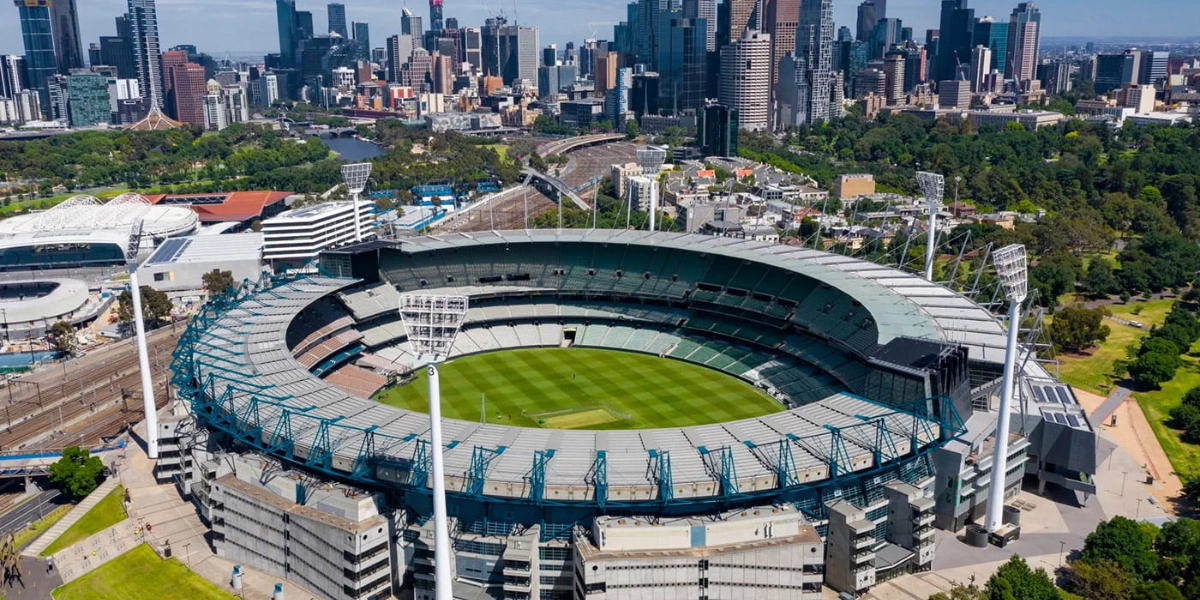Melbourne Cricket Ground (MCG)
Last updated on November 25, 2024 at 18:09 pm
Posted on July 25, 2024 at 13:53 pm
The Melbourne Cricket Ground (MCG), established in 1838, is a symbol of historic victories.
Initially established by the MCC, the MCG site was selected in 1853. The first public grandstand was erected in 1861, with an original wooden members stand built the previous year.
Over the years, the MCG has witnessed significant milestones, including hosting the world’s inaugural Test match in 1877. Significantly, the venue accommodated a record crowd of 143,750 during a Billy Graham event.
This rich history underscores the integral role the MCC played in shaping the MCG into the revered sporting arena it’s today.
Construction
The construction of the Melbourne Cricket Ground (MCG) involved significant costs, lasting impacts, and a grand opening.
The Great Southern Stand, completed in 1992 at a cost of $150 million, stands as proof of the financial investment in the venue.
This construction project not only expanded the MCG’s capacity but also left a lasting mark on its infrastructure and overall appeal.
Cost
With a staggering cost of $150 million, the Great Southern Stand at the Melbourne Cricket Ground was completed in 1992, enhancing the iconic venue’s infrastructure and capacity.
This construction project greatly increased the MCG’s seating capacity, providing state-of-the-art facilities for spectators. The investment in the Great Southern Stand not only modernized the stadium but also solidified its status as a premier sporting venue.
The considerable expense reflected the commitment to maintaining the MCG’s reputation as a world-class facility capable of hosting major events. The cost of this construction highlighted the importance of continually upgrading and expanding the venue to meet the evolving demands of sports fans and event organizers, ensuring the MCG remains a landmark of excellence in the domain of sports stadiums.
Impacts
Having greatly enhanced the Melbourne Cricket Ground’s infrastructure and capacity, the construction of the Great Southern Stand in 1992 has had profound impacts on the iconic venue. This development markedly transformed the MCG, shaping its future and solidifying its status as a world-class sporting arena.
Increased seating capacity: The addition of the Great Southern Stand expanded the MCG’s seating capacity, allowing more spectators to attend events.
Improved facilities: The construction brought modern facilities and amenities to the venue, enhancing the overall visitor experience.
Enhanced viewing experience: The new stand provided better sightlines and seating arrangements, ensuring an improved viewing experience for attendees.
Boosted revenue: The increased capacity and enhanced facilities led to a boost in revenue generation for the MCG, making it a more sustainable and profitable venue.
Opening
Following the completion of the Great Southern Stand in 1992, the construction phase of this significant addition to the Melbourne Cricket Ground began with meticulous planning and execution. The new stand was a grand project, adding a modern touch to the historic venue. Engineers and architects worked tirelessly to guarantee that the construction matched the existing structure seamlessly.
The builders faced challenges such as adhering to strict timelines and coordinating with various stakeholders involved in the project. Despite these hurdles, the construction proceeded efficiently, showcasing advanced techniques and technologies. The opening of the Great Southern Stand marked a new chapter in the MCG’s history, enhancing its capacity and facilities to accommodate a growing number of sports enthusiasts and visitors.
Development
The Melbourne Cricket Ground (MCG) has undergone significant developmental phases since its founding in 1838, resulting in its status as a premier sporting venue globally.
The construction of the Great Southern Stand in 1992 marked a significant enhancement in seating capacity and facilities.
Introduction of a full-color video scoreboard in 1982 revolutionized the spectator experience during events.
Refurbishment of the Great Southern Stand from 2011 to 2013 at a cost of $55 million modernized the infrastructure to meet contemporary standards.
Ongoing improvements in accessibility, including proximity to public transportation like Richmond and Jolimont railway stations, have made the MCG easily reachable for fans and visitors alike.
Ownership
The ownership structure of the Melbourne Cricket Ground (MCG) plays a significant role in the management and governance of this iconic sporting venue. Currently, the MCG is owned by the Government of Victoria, with the Melbourne Cricket Club (MCC) holding a long-term lease to manage and operate the ground. This unique arrangement guarantees that the MCG remains a public asset while benefiting from the expertise and traditions of the MCC in running the venue.
Australian Rules Football
With its extensive history in hosting various sports events, the Melbourne Cricket Ground (MCG) stands as a prominent venue for Australian Rules Football matches.
Here are four key aspects that highlight the significance of Australian Rules Football at the MCG:
Traditional Rivalries: The MCG has witnessed intense clashes between iconic teams like Melbourne, Richmond, Collingwood, and Essendon.
Grand Final Spectacles: The MCG hosts the highly anticipated Australian Football League Grand Final, attracting massive crowds and showcasing the pinnacle of the sport.
Historic Moments: Memorable plays and historic victories have become part of the MCG’s legacy in Australian Rules Football history.
Home Ground Advantage: Teams like Melbourne and Richmond consider the MCG their home turf, leveraging the stadium’s rich heritage and enthusiastic fan base to drive their performance.

